Many dog owners have witnessed their furry friends happily chewing on sticks while out on a walk or playing in the yard. While it may seem harmless, the question remains: is it okay for dogs to chew on sticks? The answer is not a straightforward one as there are both potential benefits and risks to this behavior.
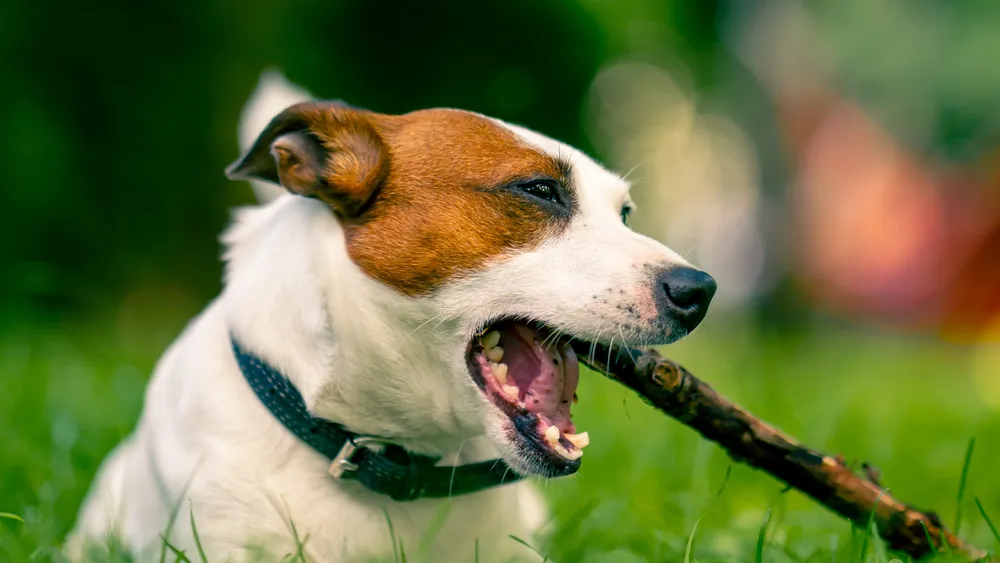
On one hand, chewing on sticks can provide mental and physical stimulation for dogs, especially those who are high-energy or easily bored. It can also help clean their teeth and gums, promoting better oral health. However, there are also risks involved, such as the potential for choking or intestinal blockages if the dog swallows a piece of the stick. Additionally, some types of wood can be toxic to dogs, causing digestive issues or other health problems.
Understanding Why Dogs Chew on Sticks
Dogs have been known to chew on sticks for a variety of reasons, ranging from instinctual behavior to boredom and anxiety. Understanding why dogs engage in this natural behavior can help pet owners determine if it is safe and appropriate for their furry friend.
Instinctual Behavior
Chewing on sticks is an instinctual behavior for dogs, as their ancestors in the wild would often chew on sticks to keep their teeth clean and strong. Additionally, chewing on sticks can provide mental stimulation and help satisfy a dog's natural urge to chew.
Teething in Puppies
Puppies may also chew on sticks as a way to alleviate discomfort during the teething process. Chewing on a stick can help soothe their sore gums and provide relief from the pain.
Curiosity and Exploration
Dogs are naturally curious animals and may chew on sticks as a way to explore their environment. This behavior can also be a way for dogs to mark their territory by leaving their scent on the stick.
Boredom and Anxiety
In some cases, dogs may chew on sticks out of boredom or anxiety. This behavior can become problematic if the dog begins to ingest the stick, which can lead to health issues such as intestinal blockages or pica.
Overall, while chewing on sticks is a natural behavior for dogs, pet owners should monitor their dog's behavior and ensure that they are not ingesting the stick or engaging in the behavior out of boredom or anxiety. Providing appropriate chew toys and mental stimulation can help redirect this behavior in a safe and healthy way.

Potential Risks of Chewing on Sticks
Dogs love to chew on sticks, but it's important to be aware of the potential risks associated with this activity. Here are some of the risks to keep in mind:
Choking Hazards
Sticks can break apart and become lodged in a dog's throat, causing choking. This is especially true for smaller sticks or dogs with smaller airways. If your dog is choking, they may paw at their mouth, cough, or have difficulty breathing. It's important to seek veterinary attention immediately if you suspect your dog is choking.
Splinters and Internal Injuries
Chewing on sticks can also lead to splinters or other internal injuries. Splinters can get stuck in a dog's gums, causing pain and irritation. Larger splinters can cause more serious internal injuries, such as puncturing the digestive tract. Signs of internal injuries may include vomiting, constipation, or unusual bowel patterns. If you suspect your dog has an internal injury, seek veterinary attention immediately.
Toxic Substances from Trees
Some trees, such as yew and black cherry, can be toxic to dogs. Ingesting parts of these trees, such as the foliage or bark, can cause vomiting, diarrhea, weakness, pacing, raspy panting, lack of focus, and dilated pupils. In severe cases, it can lead to difficulty breathing and even death. It's important to be aware of the types of trees in your area and prevent your dog from ingesting any parts of them.
Digestive Tract Obstructions
Chewing on sticks can also lead to digestive tract obstructions. Large pieces of stick can get stuck in a dog's stomach or intestines, causing pain, infection, and even death if left untreated. Signs of digestive tract obstructions may include vomiting, diarrhea, constipation, and tooth pain. If you suspect your dog has a digestive tract obstruction, seek veterinary attention immediately.
Overall, while dogs may enjoy chewing on sticks, it's important to be aware of the potential risks and take steps to prevent them. Providing safe chew toys and supervising your dog while they play can help keep them healthy and happy.
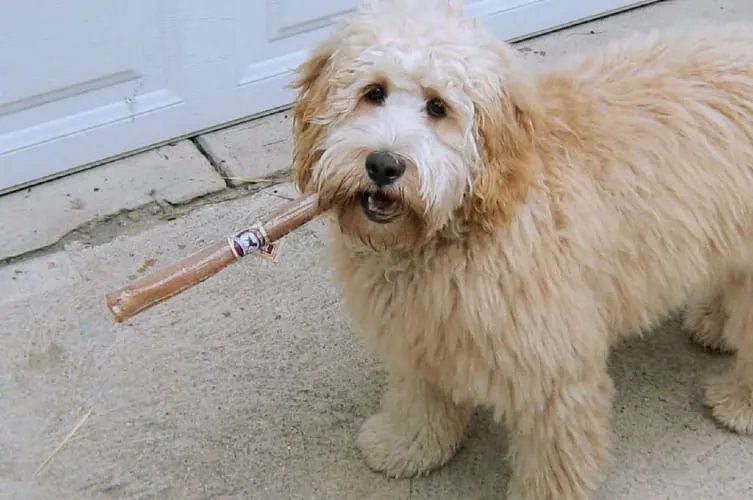
Promoting Safe Chewing Habits
Dogs love to chew on things, and sticks are no exception. However, chewing on sticks can be dangerous and lead to serious health issues. As a responsible dog owner, it is important to promote safe chewing habits for your furry friend. Here are some tips to help you do just that.
Providing Appropriate Chew Toys
One of the best ways to promote safe chewing habits is to provide your dog with appropriate chew toys. There are many types of chew toys available, including rubber toys, bones, and rope toys. It is important to choose toys that are durable and safe for your dog to chew on. Consult with your veterinarian to determine which types of chew toys are best for your dog.
Training to Avoid Sticks
Training your dog to avoid sticks is another important step in promoting safe chewing habits. Teach your dog to "leave it" when he encounters a stick. This can be done through positive reinforcement training. When your dog obeys your command, reward him with a treat or praise. With patience and consistency, your dog will learn to avoid sticks and other dangerous objects.
Monitoring Your Dog's Behavior
Monitoring your dog's behavior is also important in promoting safe chewing habits. Keep an eye on your dog when he is outside and make sure he is not chewing on sticks or other dangerous objects. If you see your dog chewing on a stick, redirect his attention to a chew toy or other safe object. It is also important to regularly check your yard for sticks and other hazardous objects and remove them promptly.
By following these tips, you can promote safe chewing habits for your dog and help prevent serious health issues. Remember to always consult with your veterinarian for advice on the best chew toys and training methods for your furry friend.
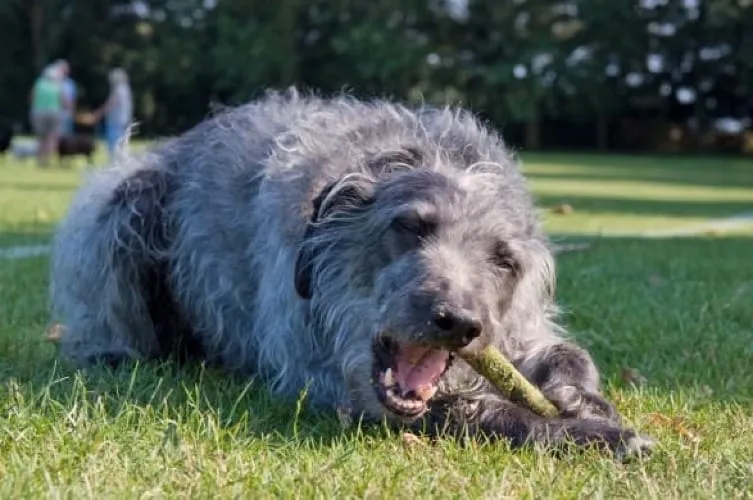
Recognizing and Responding to Complications
Dogs have a natural instinct to chew on objects, including sticks. While chewing on sticks may seem harmless, it can lead to complications that should not be ignored. It is important for dog owners to recognize the signs of oral and gastrointestinal distress and know when to consult a veterinarian.
Signs of Oral and Gastrointestinal Distress
Chewing on sticks can cause harm to a dog's mouth, teeth, and gums. Splinters from the stick can get stuck in a dog's mouth, causing pain and bleeding. In addition, the stick can break and cause tooth pain or even infection.
If a dog is experiencing oral pain, they may exhibit signs such as drooling excessively, pawing at their mouth, or avoiding food and water. They may also exhibit body language that suggests discomfort, such as whimpering or shaking their head.
Ingesting pieces of the stick can also lead to digestive issues, such as vomiting, constipation, or diarrhea. If a dog is experiencing gastrointestinal distress, they may exhibit signs such as coughing, vomiting, or a lack of appetite.
When to Consult a Veterinarian
If a dog is exhibiting signs of oral or gastrointestinal distress, it is important to consult a veterinarian. The veterinarian can examine the dog's mouth and determine if there is any damage or infection. They may also recommend X-rays to check for any internal damage.
If a dog has ingested a large piece of the stick or is experiencing severe symptoms, it is important to seek immediate veterinary care. Ignoring these symptoms can lead to further complications and harm to the dog's health.
In conclusion, while chewing on sticks may seem like a harmless activity for dogs, it can lead to complications that should not be ignored. Dog owners should be aware of the signs of oral and gastrointestinal distress and know when to consult a veterinarian. By taking the appropriate steps, dog owners can ensure their pet's health and well-being.
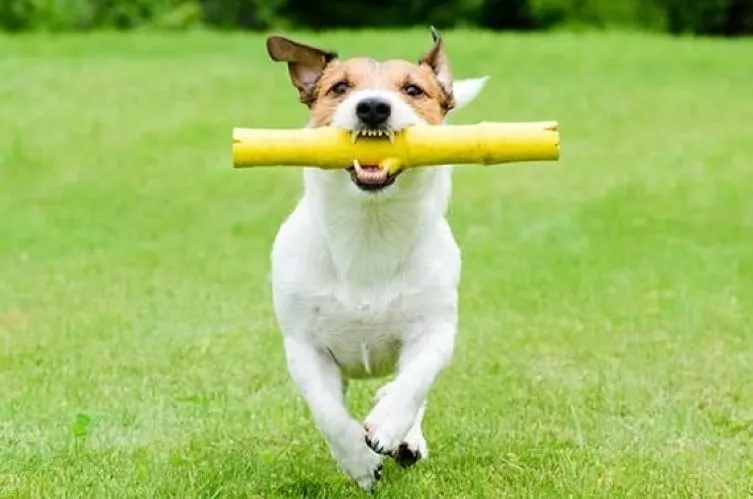
Alternatives to Sticks
When it comes to finding safe and healthy chew toy options for dogs, there are plenty of alternatives to sticks. Here are a few options to consider:
Safe Chew Toy Options
One of the best ways to keep dogs from chewing on sticks is to provide them with safe chew toys. Chew toys are specifically designed to satisfy a dog's natural urge to chew, and they come in a wide variety of shapes, sizes, and materials. Some popular options include rubber toys, nylon bones, and rope toys.
When selecting chew toys for your dog, it's important to choose toys that are appropriate for their size and chewing style. Toys that are too small can be a choking hazard, while toys that are too hard can damage teeth. Always supervise your dog while they are chewing to ensure their safety.
Natural Ingredient-Based Chews
If you prefer to provide your dog with natural ingredient-based chews, there are plenty of options to choose from. Rawhide chews, for example, are made from the inner layer of cow or horse hides and are a popular choice for many dog owners. However, it's important to note that rawhide chews can be a choking hazard and may also contain harmful chemicals.
Other natural ingredient-based chews include antlers and pig ears. Antlers are a great option for dogs who love to chew, as they are long-lasting and come in a variety of sizes. Pig ears are also a popular choice, but they can be high in fat and calories, so it's important to monitor your dog's intake.
Interactive Play and Exercise
In addition to chew toys and natural ingredient-based chews, interactive play and exercise can also help satisfy a dog's urge to chew. Playing fetch with a ball or frisbee, for example, can provide a great workout for your dog and help them burn off excess energy. Puzzle toys and treat-dispensing toys are also great options for dogs who love to chew and play.
Overall, there are many safe and healthy alternatives to sticks when it comes to satisfying a dog's urge to chew. By providing your dog with a variety of chew toys, natural chews, and interactive play options, you can help keep them happy, healthy, and entertained.
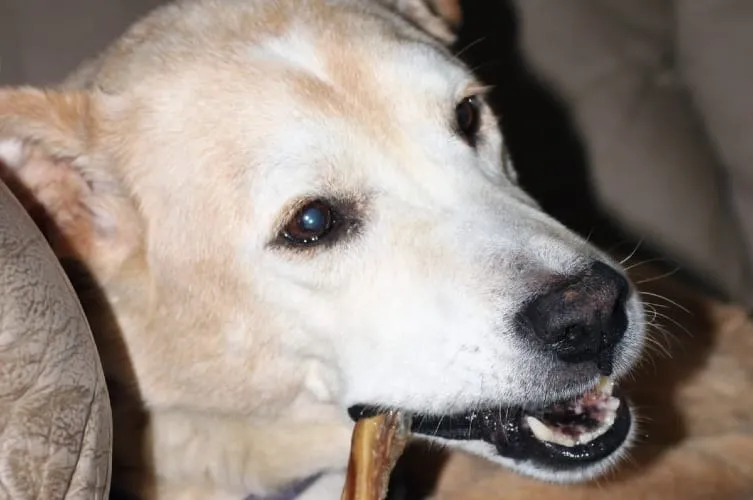
Maintaining Your Dog's Dental Health
Dental health is an essential aspect of your dog's overall health. Neglecting your dog's dental health can lead to dental issues, which can cause pain, discomfort, and even affect your dog's ability to eat. Here are some tips to help maintain your dog's dental health.
Regular Dental Checkups
Regular dental checkups with a veterinarian are crucial to maintaining your dog's dental health. During a dental checkup, the veterinarian will examine your dog's teeth and gums, and check for any signs of dental issues such as plaque, tartar buildup, or gum disease. The veterinarian may also recommend a professional dental cleaning to remove any buildup of plaque or tartar, which can lead to dental issues.
Choosing the Right Chew Toys
Chew toys can be an excellent way to help maintain your dog's dental health. However, it's essential to choose the right chew toys. Hard objects like rocks, antlers, or bones can cause dental issues such as broken teeth or damage to the gums. Instead, choose chew toys that are soft, pliable, and specifically designed for dental health. Some chew toys are designed to clean teeth, massage gums, and freshen breath.
It's important to note that not all chew toys are suitable for all dogs. Some dogs have a more aggressive chewing style and may require more durable chew toys. Consult with your veterinarian to determine the best chew toys for your dog's specific needs.
In conclusion, maintaining your dog's dental health is essential to their overall health and well-being. Regular dental checkups with a veterinarian and choosing the right chew toys can help prevent dental issues and keep your dog's teeth and gums healthy.
Frequently Asked Questions
Why Do Dogs Eat Sticks and Leaves?
Dogs are natural foragers, and chewing on sticks and leaves is an instinctual behavior that dates back to their wild ancestors. In the wild, dogs would chew on sticks and leaves to clean their teeth, exercise their jaws, and satisfy their natural urge to chew. However, when dogs chew on sticks and leaves in the home environment, it can be a sign of boredom, anxiety, or a nutritional deficiency.
How Can I Stop My Dog from Eating Sticks?
The best way to stop your dog from eating sticks is to train your dog to leave sticks and other non-food items alone. This can be achieved through positive reinforcement training, where you reward your dog for good behavior and ignore bad behavior. You can also provide your dog with plenty of chew toys and bones to satisfy their need to chew. Additionally, providing your dog with enough physical and mental stimulation can help reduce their urge to chew on non-food items.
What Are the Signs My Dog Has Eaten Something Harmful?
If your dog has eaten something harmful, they may display symptoms such as vomiting, diarrhea, lethargy, loss of appetite, and abdominal pain. In severe cases, your dog may experience seizures, coma, or even death. If you suspect that your dog has eaten something harmful, it is important to seek veterinary care immediately.
Overall, while it is natural for dogs to chew on sticks and leaves, it is important to monitor their behavior and provide them with appropriate chew toys and mental stimulation. By doing so, you can help prevent your dog from ingesting harmful substances and ensure their overall health and well-being.
Creating a Safe Environment
When it comes to allowing dogs to chew on sticks, it's important to create a safe environment for them to do so. This means taking steps to dog-proof your yard and identifying any hazardous plants that may be present.
Dog-Proofing Your Yard
To dog-proof your yard, start by removing any potential hazards such as sharp objects, toxic chemicals, and small objects that could be swallowed. It's also important to secure any loose fencing or gates to prevent your dog from escaping.
In addition, consider providing your dog with plenty of toys and chewables to redirect their instinctual behavior towards appropriate items. This can help decrease the likelihood of them chewing on sticks or other hazardous items.
Identifying Hazardous Plants
Certain plants can be toxic to dogs, and it's important to identify and remove them from your yard. For example, walnut trees can be harmful to dogs if ingested, so it's important to keep them out of reach.
Consulting with a veterinarian or doing research on hazardous plants in your area can help you identify and remove any potential dangers.
By taking these steps to create a safe environment for your dog, you can help prevent any potential harm from chewing on sticks or other hazardous items. Remember to always supervise your dog while they are playing outside and replace any chewables that become worn or damaged.
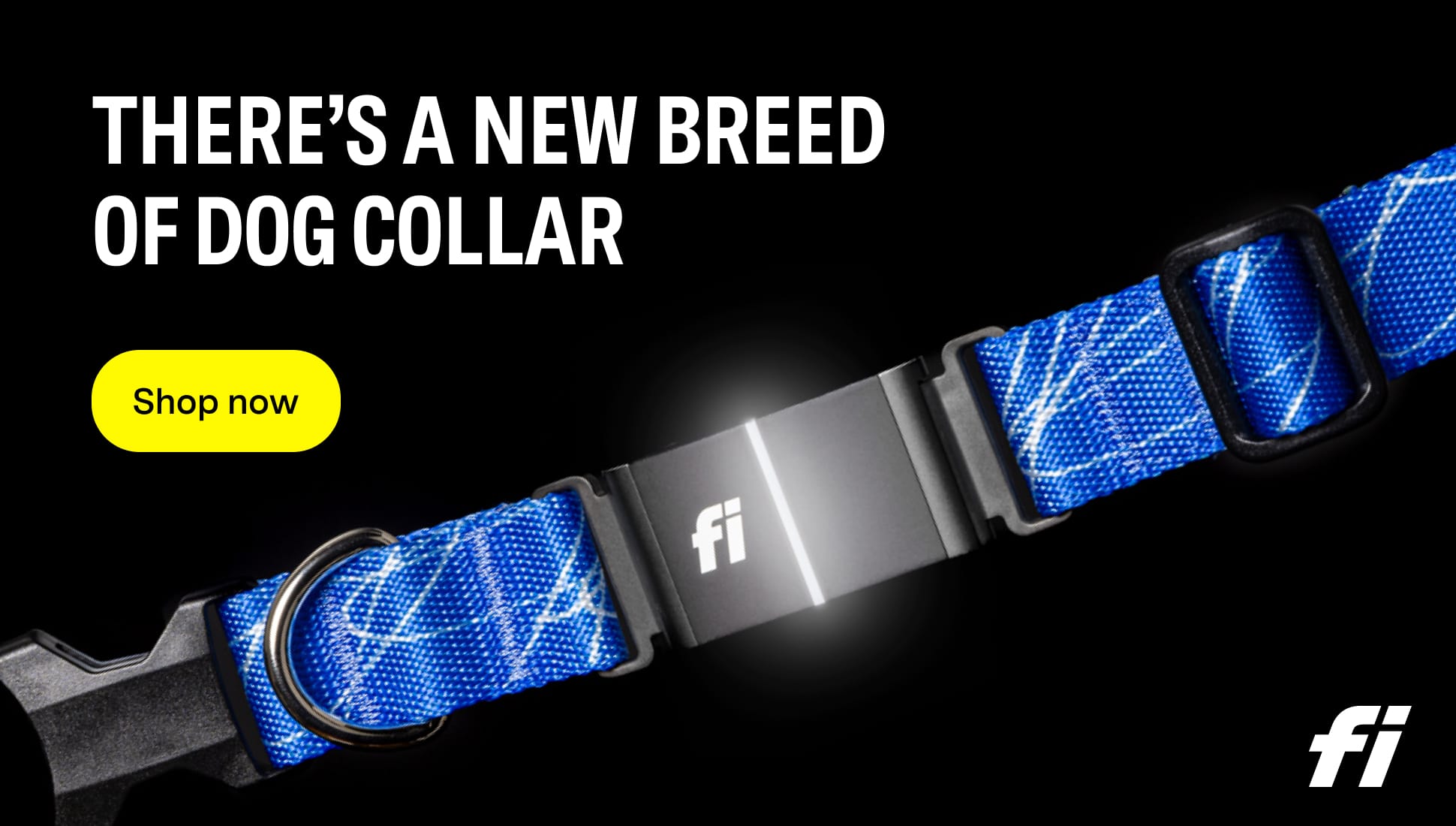
Understanding Dog Behavior and Safety
The Role of Foraging in Dog Behavior
Dogs are natural foragers and enjoy exploring their environment with their mouths. Chewing on sticks, bones, and other objects is a common behavior for dogs. This instinctual behavior is rooted in their history as wild animals and is a natural way for them to relieve anxiety and frustration.
However, chewing on sticks can pose safety risks for dogs. Sticks can splinter and cause serious injuries to the mouth, throat, and digestive system. In addition, dogs may ingest toxic substances or sharp objects that can cause internal damage.
To prevent these risks, it is important for dog owners to provide safe and appropriate chewing materials for their pets. This can include specially designed chew toys or bones that are made for dogs to chew on.
Training for Safety and Obedience
To ensure the safety and well-being of dogs, it is important for owners to teach and train their pets. Training can help dogs learn to obey commands, understand body language, and communicate effectively with their owners.
Training can also help dogs overcome anxiety and frustration, which can lead to destructive behaviors such as chewing on sticks. By providing positive reinforcement and consistent training, owners can help their dogs learn appropriate behaviors and avoid dangerous situations.
In addition, it is important for owners to understand their dog's breed and instinctual behavior. Some breeds may be more prone to chewing on sticks or other objects, and owners should be aware of these tendencies and take appropriate precautions.
Overall, understanding dog behavior and safety is essential for responsible pet ownership. By providing safe and appropriate chew materials and training their dogs, owners can help their pets stay healthy and happy.
Conclusion
In conclusion, while chewing on sticks is a natural and instinctual behavior for dogs, it's essential for pet owners to be aware of the potential risks and take proactive measures to ensure their furry friends' safety. The benefits of chewing, such as dental health, mental stimulation, and relief during teething, are significant. However, the dangers, including choking hazards, internal injuries, exposure to toxic substances, and digestive tract obstructions, cannot be overlooked.
To promote safe chewing habits, dog owners should provide appropriate chew toys, engage in training to deter stick chewing, and monitor their pets' behavior closely. Regular dental checkups and creating a safe environment by dog-proofing yards and removing hazardous plants are also crucial steps in safeguarding dogs' well-being. By understanding the reasons behind stick chewing and responding with suitable alternatives and precautions, dog owners can ensure their companions enjoy the benefits of chewing without the associated risks, thereby supporting their overall health and happiness.
FAQs
Q: Can dogs chew on bones instead of sticks?
- A: Yes, dogs can chew on bones, but it is important to choose appropriate bones that are safe for your dog to chew on. Consult with your veterinarian for advice on the best types of bones for your dog.
- Q: Are dog toys effective in preventing chewing on sticks?
- A: Yes, providing appropriate dog toys can help prevent your dog from chewing on sticks. However, it is important to monitor your dog's behavior and provide positive reinforcement training to reinforce good chewing habits.
- Q: How can I dog-proof my yard to prevent my dog from chewing on sticks?
- A: Regularly inspect your yard for hazardous objects, such as sticks and other sharp objects, and remove them promptly. You can also provide your dog with plenty of chew toys and supervise him when he is outside to ensure he is not chewing on dangerous objects.




